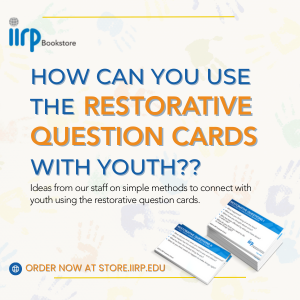Unlock the power of meaningful conversations with the students and children in your life using the Restorative Questions. Not only are they extremely useful in resolving conflicts, but these questions elevate everyday moments into opportunities for connection and growth. Whether in the classroom, at home, or on the go, restorative practices foster understanding and strengthen relationships. Discover how these simple yet profound questions can enrich your interactions and empower young minds.
Also called Affective Questions, they are a simple yet powerful structure that assists children in processing their thoughts and actions in a beneficial way:
- What happened?
- What were you thinking of at the time?
- What have you thought about since?
- Who has been affected by what you have done? In what way?
- What do you think you need to do to make things right?
So, how do you use them?
To process. learn from, and effectively address harm caused.
Restorative practices revise the way we approach conflict by creating an opportunity to foster learning and build better relationships. When responding to a challenging situation, each question pushes the child to reflect more and more deeply. As children respond, they step closer to understanding the impact of their actions and learn empathy. The final question seeks to find solutions and places the agency on those involved in a conflict to determine the best steps forward.
Use the questions proactively.
While the original questions are presented in a responsive format, making them proactive is a simple switch. This approach not only introduces the structure to children in a positive way, but it also begins to allow them to adjust to this thinking outside of times of stress. The more exposure children have to processing and reflecting in this way, the better equipped they will be to respond when facing harm. Encourage turn-taking and active listening while you ask:
- What’s going well for you this week?
- Has anyone helped you recently? How?
- What’s something kind you’ve done lately?
Try the questions out as a role-play.
Equip students to handle various situations in advance through interactive role-play. Present hypothetical situations or common school scenarios (e.g., someone takes a toy, cuts in line). Then ask the group to practice answering the affective questions. This makes the process accessible without pressure and allows children to reflect on how they would respond in similar situations.
Reinforce the questions visually.
To reinforce the use of affective questions as part of the standard approach to problem solving and communicating with others, having them printed and displayed is helpful. They can also be added to the back of staff and student ID badges as a quick reference. In moments of stress, we are the least likely to be able to think clearly, and having the questions on hand without having to remember something from a training or a poster in a classroom can quickly redirect a tense conversation to a productive resolution.
Use them as a book reflection.
As you read a story with your child, pause along the way to ask the Restorative Questions and reflect more deeply on the moral of the story. Consider asking:
- What happened?
- What do you think they were thinking or feeling?
- Who was impacted and how?
- What could they do to make things right? Or, what did they do to make things right, fix the problem, or move forward?
This approach introduces the questions in a thoughtful way and helps them feel more approachable, which helps ease the tension when they are used with children to process a challenging situation in the future.
Use them intentionally in everyday situations.
In responsive moments, the questions are focused on challenges and perhaps the need to make something better. In proactive discussions, the questions are focused on successes and joys. Either way, the questions serve as a guide in opening an authentic space to talk.
The first question, “What happened?” can apply to any situation: family, friends, children, coworkers. It can serve as the first response when someone shares joy, sorrow, frustration, or unexpected news. It does two things: it invites this person to share their story, and it reminds us to listen and provide space for them to share their experience.
Part of feeling a true sense of belonging is having our voices heard. When students and youth in general have the opportunity to tell their stories, a light shines from them. Using the questions in moments of celebration will not only highlight the joys but also build a stronger connection. “This person cares what I have to say,” can easily become, “I’m having a problem and need that person who cares.”
Young people need adults to be present with them in the moment. By using the restorative questions proactively and responsively, they will know that you want to know what's happening in their life, how they feel, what they are thinking, and its impact on themselves and those in their lives.

